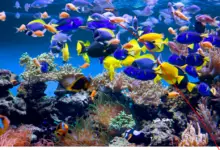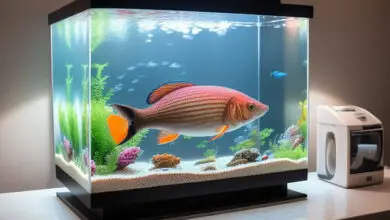Keeping Fish Simple- A Minimalist Guide for Beginner Aquarists

Many people are drawn to the idea of having a home aquarium full of colorful fish and aquatic plants. However, tending to the needs of fish and managing water quality can quickly become complex and time-consuming. From heating and filtration systems to testing water parameters, there is a lot to learn when you first set up a new tank. However, keeping fish does not have to be overly complicated, especially if you take a minimalist approach.
Why Go Minimalist?
When first starting out in the fishkeeping hobby, it is easy to get overwhelmed by all of the equipment and maintenance that modern high-tech tanks require. Going with a minimalist tank setup allows beginners to dip their toes into fish ownership without as steep of a learning curve.
Some key benefits of minimalist fishkeeping include:
- Lower Startup Costs: A basic, no-frills tank with just a few hardy fish is far less expensive than a fully loaded high-tech planted aquarium. This makes the hobby more accessible.
- Less Equipment & Maintenance: With fewer mechanical components like filters and heaters, there is less to clean and replace. Water changes can also be less frequent.
- Increased Focus on the Fish: Simple tanks shift focus back onto the livestock rather than distracting aquascapes and technology. This can lead to better animal husbandry.
- More Room for Error: The less complex the tank, the more forgiving it is of beginner mistakes. Simple systems are bounces back easier if things get off balance.
If you find high-tech tanks exciting but overwhelming as a newcomer, consider starting with a minimalist approach. Once you get some experience under your belt, you can always upgrade and add more gear to your setup after learning the basics!
Choosing Suitable Fish
The key to success with a minimalist tank is sticking with fish species that are tolerant of a wide range of water parameters and temperatures. Sensitive species that require strict conditions should be avoided until you have a better grasp of fish care basics.
When stocking a starter tank, select fish that are:
- Hardy & Adaptable: Fish that can handle some variability in pH, hardness, and temperature fluctuations. They bounce back from beginner mishaps more easily.
- Peaceful & Solitary: Avoid aggressive fish that might fight or schooling species that prefer larger groups. Territorial loners are easier for novice aquarists.
- Small Species: Large fish have higher waste output and may grow too big for simpler tanks. Go for fish that stay under 3 inches full grown.
Some great beginner species to consider include:
- Bettas
- Guppies
- Platies
- Zebra Danios
- White Cloud Mountain Minnows
- African Dwarf Frogs
Focus on just one or two fish types to start rather than cramming your tank with lots of different species. Make sure any tankmates cohabitate peacefully.
Setting Up the Tank Simply
When it comes to equipment, think simple for a hassle-free home for your fish. Some easy setup options include:
- Standard Glass Aquariums: Time tested and affordable, glass tanks up to 20 gallons are perfect for minimalist beginner setups. They lack integrated filtration but provide basic home.
- Sponge Filters: These super basic filters just require an air pump and provide all the biofiltration you need. Add a spritz bar for surface agitation.
- Substrate & Decor: Opt for inert sand or gravel. Include just a few décor pieces like smooth rocks or clay pots for fish to explore and hide in. Have fun sourcing interesting driftwood or stones.
- Mini Heater (Optional): If your home gets cool, a small 25-50 watt aquarium heater can help maintain temperatures. Test to see if room climate keeps water in safe range for your fish selection without added heat.
- Natural Daylight Cycle: Situate tank near a bright window and leverage natural light instead of artificial tank lighting. This also establishes healthy day/night rhythm.
Advanced gear like water testing kits, air pumps, gravel vacuums or other accessories can be added down the road as your system expands. But a basic tank with sponge filtration is enough to get started!
Easy Plant Options
Live plants help stabilize tank ecosystems but novices often struggle with complex planted aquarium setups. When just getting started, opt for a few hardy, fast-growing stem plants instead of meticulously aquascaped arrangements.
Some easy beginner aquarium plant varieties to consider include:
- Anacharis: This fast growing oxygenating stem plant thrives in a wide range of conditions. It helps control algae and provides shade.
- Java Fern: An iconic aquarium plant with broad leaves. Java fern tolerates low light and just anchors to décor – no planting required!
- Amazon Sword: A hardy rosette plant with long leaves. It grows extensive root systems and is a nitrate sponge. Great background plant.
- Java Moss: This versatile moss attaches to driftwood or stones. It provides soft hideaways for shy fish and helps protect fry.
- Duckweed: Tiny floating plants that provide overhead shade. Duckweed also outcompetes nuisance algae and absorbs excess nutrients.
Stem plants can be trimmed back when overgrown and floating plants scooped out by the handful. This makes maintaining plants in your first tank simple!
Minimizing Maintenance Needs
Once your minimalist tank system is fully cycled and balanced, maintenance is fairly straightforward. Here are some easy fishkeeping tasks to practice:
- Partial Water Changes: For small tanks, replace 25% of the water weekly. Use a gravel vacuum to siphon waste from substrate or employ the “stir and dip” method if plants prohibit vacuuming.
- Filter Media Rinsing: About once a month, swish sponge filters in old tank water to clear debris. Never replace cartridges all at once to avoid crashing the nitrogen cycle!
- Feeding Small Amounts: Start with tiny pinches of food once or twice a day. Fast fish for a day per week to avoid waste buildup. Observe fish behavior and appetite to fine tune diet.
- Algae Wiping: Use an algae scrubber or paper towel to spot clean glass when needed. Twice a week is usually sufficient to keep growth in check.
- Top Offs: Add treated water periodically though the week if evaporation causes water line to dip more than an inch or two. This maintains safe parameters.
Test water periodically with quick dip strips as tank matures to confirm ammonia and nitrite stay at zero ppm. After a few months, minimal upkeep preserves stable habitats!
Expanding Your System Over Time
The wonderful thing about simple starter tanks is that they provide the skills foundation for delving into the more complex side of the hobby down the road. Once confident keeping basic species healthy with minimal gear, have fun adding on with:
- Additional filtration power like hang-on-back filters or canister systems to upgrade life support for more delicate species.
- Advanced lighting systems and CO2 injection to grow lush carpets of aquatic plants.
- Automatic top off kits, dosing pumps or pellet feeders to take automation and precision.
- Chillers, UV sterilizers, protein skimmers or other gear for unique biotope or species tanks.
There are always new techniques to explore and ways to upgrade your system. But remember to walk before you run! Embrace the simplicity first and your future dream tank will feel much more manageable.
Frequently Asked Questions
What size tank is best to start with?
For first aquariums, a 10 or 20 gallon tank is ideal. This size provides ample room for a few small fish while remaining portable enough to situate easily at home. The smaller water volume also simplifies maintenance.
How many fish can I add to a beginner tank?
Stock very lightly at first while your system stabilizes. Shoot for just one inch of fish per gallon of water to avoid overloading the biofilter. So a 20 gallon tank could house 5-6 two inch fish once established. Build stocking levels gradually over months.
Is a heater absolutely necessary for tropical fish?
In general water temperatures between 72-82°F are tolerated by most common tropical fish sold today. If your home stays consistently in that range year round, you may be able to forego an aquarium heater, especially if selecting adaptable species.
How often should I change the water?
To start, aim to change out 25% of the total tank’s water volume each week. Once your tank matures after a few months, testing can help determine if less frequent water changes would be sufficient to maintain safe parameters for livestock.
Why avoid undergravel filters in starter tanks?
While classics, undergravel filters can be tricky for newcomers to clean properly. The gravel bed tends to fill with debris over time which can spike ammonia. Stick to easily rinsed sponge filters when first getting the hang of tank maintenance.
Starting out with a minimalist tank setup as a beginner fishkeeper has many advantages







